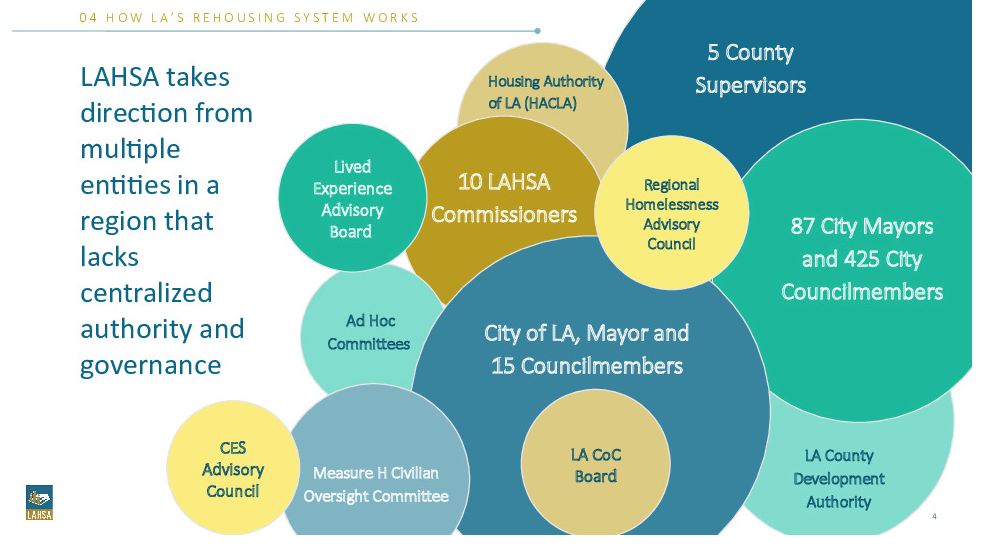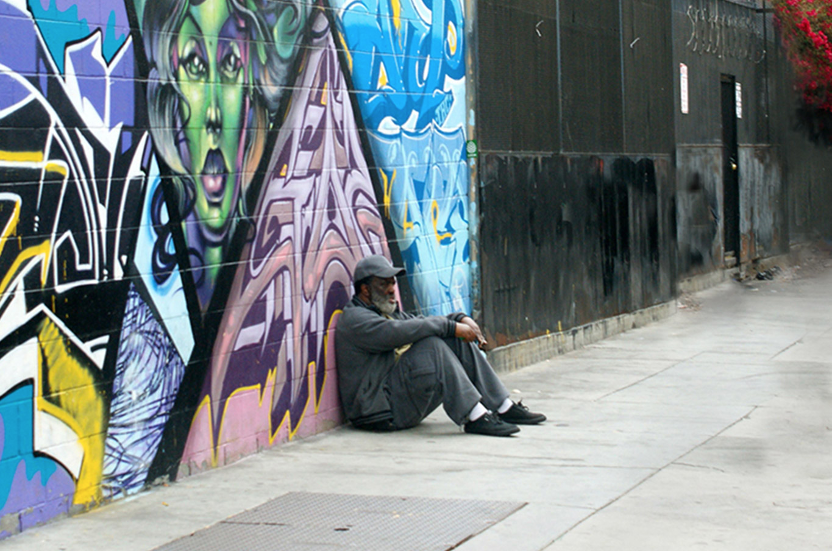CommentsTHE EASTSIDER - As I pointed out in an earlier post, LAHSA has been officially around since 1993, when LA County and the City of Los Angeles created LAHSA as a joint powers authority to deal with the homeless.
While I looked at the net effect of LA City and LA County’s attempts to copy with our exploding homeless problem in the earlier post, I was unable to see how that entity actually works because no one there would talk to me.
Recently I was able to directly talk to a key executive there, so here is a look at who they really are and how it works in their attempts to cope with our seemingly endless homeless population.
As the graphic shows, LAHSA receives ‘direction’ from literally hundreds of political entities. The big two, of course are LA City and LA County. And within those two bodies, there are a number of subdivisions:

In LA City we have the Mayor and the City Council, but thee’s more - LA has a City Homeless Initiative, the HHH Administrative Oversight Committee, and a HHH Citizens Oversight Committee. How all this has worked under the stewardship of our largely absent Mayor Eric Garcetti is fodder for another tale.
In LA County, of course, we have the 5 member Board of Supervisors, their CEO, the LA Count;y Homeless Initiative, and their Measure H Citizen Oversight Committee.
For those unfamiliar with the jargon, Measure HHH was a $1.2 Billion dollar bond measure by LA City. to help house the homeless. That means you and I pay for the bond. And what did LA City do? They pissed away most of the money on $800,000 housing units, that’s what.
Over in the County, Measure H was a 10 year 1/4 cent sales tax to provide supportive services to the homeless, in order to transition them back into society. You can find the details of this tax on Ballotpedia:
Los Angeles County Plan to Prevent and Combat Homelessness. To fund mental health, substance abuse treatment, health care, education, job training, rental subsidies, emergency and affordable housing, transportation, outreach, prevention, and supportive services for homeless children, families, foster youth, veterans, battered women, seniors, disabled individuals, and other homeless adults; shall voters authorize Ordinance No. 2017-0001 to levy a ¼ cent sales tax for ten years, with independent annual audits and citizens’ oversight?”
They both passed, of course. Between the two measures, they account for around 79% of LAHSA’s funding, as I pointed out in an earlier article. So concentrating on the City and County bureaucracy, they both provide the primary juice in the LAHSA Commission. In turn, the Commission runs the LA Homeless Services Authority, LAHSA.
Whew! And we’ve just begun.
The Real Bottleneck
The real work of the LAHSA staff relies on three pillars; Prevention, Housing Supply, and Rehousing System. Prevention is what you and I would refer to as the basic safety net that our tax dollars are supposed to provide.
Housing supply includes both shelters and permanent supportive housing, while the Rehousing system has to do with supportive services to move the homeless into temporary and hopefully permanent housing.
This all sounds good, and LAHSA even has a cute pyramid graphic, with LAHSA at the top of the pyramid responsible for primary responsibility in the area of rehousing. To make this system work, they estimate that it takes something like 5 real housing opportunities for each shelter bed, and that ain’t happening.
Analyzing their data, it looks like the current LAHSA system can handle around 20,000 people per year. That will never produce even a dent in hopelessness. Take just the City of Los Angeles, where we estimate over 40,000 homeless at any time.
As an ex Social Worker back in the day, you can safely assume that somewhere between 25 to 30% of the homeless will have significant alcohol and/or drug issues. That would account for some 10,000 people where any rehousing system is bound to fail. Each of those people will require a huge amount of resources to really help them.
So call it 30,000 potential success stories in LA City in any given year. But the LAHSA system can only average around 20,000. AND THATS JUST IN LA CITY.
Here’s the very bad news from the size of LA County, straight from Wikipedia:
“Los Angeles County, officially the County of Los Angeles, [7] and sometimes abbreviated as L.A. County, is the most populous county in the United States and in the U.S. state of California, [8] with more than ten million inhabitants as of the 2020 census.[9] It is the most populous non-state-level government entity in the United States. Its population is greater than that of 40 individual U.S. states. Los Angeles County has the 3rd largest metropolitan area economy in the world, with a nominal GDP of more than $1.0 trillion. At 4,083 square miles (10,570 km2) and with 88 incorporated cities and many unincorporated areas, it is larger than the combined areas of Delaware and Rhode Island. The county is home to more than one-quarter of California residents and is one of the most ethnically diverse counties in the United States.[10] Its county seat, Los Angeles, is also California's most populous city and the second most populous city in the United States, with about four million residents.”
I have no idea, nor have I seen any statistical information as to how many homeless there are in LA County, so let’s guesstimate. If LA City is about 40% of the County and produces say 40,000 current homeless, the County is likely to produce something like 60,000 homeless. And I would love to be wrong. Because the total here is 100,000 or more homeless in LA County, even as the current Joint Powers entity of LAHSA can only cope with 20,000, using their own data.
Therein lies the sad outcome to our analysis. The amount of additional taxes required to fund all this is simply never going to happen in my lifetime. No matter what any politician says.
Food For Thought
There are a number of immediate lessons from our look at LAHSA, the County & the City of LA’s combined response to record hopelessness
First, there is no simple solution to our homeless problem that any politician can deliver on even as they run for office. If they promise one, they haven’t looked at the numbers, or, they are flat out lying.
Second, there is still further analysis needed on parts of LAHSA as we know it. I believe there are significant issues with the Provider System, which is the one that produced Hope of the Valley running Kevin De Leon’s Tiny Village in Highland Park. What exactly is the process when an NGO files to be certified, what’s involved, and how the final decision is made by LAHSA are all ripe for looking into.
Also, as a LA City resident, it should be noted that the LAHSA Board is comprised of 5 political appointees from the LA County Board of Supervisors, and thanks to our missing Mayor, two of his 5 positions on the Board are currently vacant, and two of the three appointees date back to Antonio Villaraigosa! Now there’s real meaningful action by our missing Mayor. Thanks a bunch, Eric.
Finally, while the homeless don’t vote, for sure the politicians have discovered that people paying $2000-$3000 per month for their home or apartment do vote. They resent the encampments all over their communities, often rife with drugs and crime. I think that’s why the City Council adopted the Ordinance giving each Councilmember the ability to roust encampments. Like that worked.
Final Thought
A year or so ago I wrote an admittedly provocative article called A Solution to LA’s Homelessness-Garcettiville!.
It involved a large, undeveloped part of LA, which could serve as an alternative to the homeless encampments all over LA. Sort of like President Hoover’s Hooverville.
At the time it was a swipe at Mayor Garcetti and the Council for their incompetence in dealing with the homeless. But maybe, just maybe, we should reconsider the idea.
(Tony Butka is an Eastside community activist, who has served on a neighborhood council, has a background in government and is a contributor to CityWatch.)






